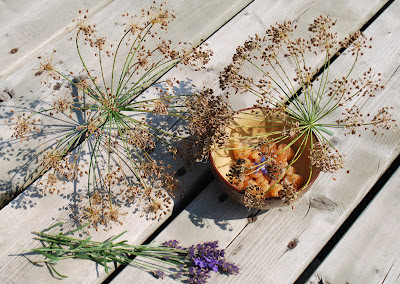Cet article en français.
Este artículo en español.
Hélène :
A lot of my friends and acquaintances don't like the taste of licorice given off by certain plants like star anise, dill, fennel, anise hyssop and even oregano. I am not a big fan of it myself, although I lately became much more tolerant of it.
 |
| Anise hyssop blooms are a delight for my bees. They are edible too! At least if you like the taste of licorice. |
 |
| July's harvest, 2 dill flower heads, a couple of lavender stalks and flowers, the first golden raspberries and a borage flower (the blue star in the raspberries). |
It started with dill when I bought a tiny plant last year, for the sole purpose of pleasing the beneficial insects gracing my garden like the bees. I found dill to be a very pretty plant, at least to my eye, with finely ciseled blue-green leaves. Next come the flowers, looking like big parasols and filled with tiny yellow flowers giving the whole head the aspect of a star. They also have a divine scent. Those flowers then transform into minuscule brown, striped seeds with a pretty white edge. Even the stalk is striped pale green and bluish-green! Little there is to say, from its 4 feet high, the dill caught my eye. And then my nose. Only a couple of flower heads are needed to fill the house with a lovely summer scent. Finally, I tasted it and was left flabberghasted. This had nothing to do with the thing on the spice rack at the grocery store! For the first time, I liked the taste of licorice.
 |
| Only the third of my summer 2012 harvest. Considering this is a plant that requires almost nothing from me and one that came back on its own from last year, the reward is substantial! |
The next salad had fresh dill in it, of course, and the result was such that I haven't made one without it since. Other uses for this plant : You can use the seeds in a bread, or make an herbal tea with them, one that helps stomach aches. Or the eternal classic, a flower head added to a home-made pickle jar.
There is much more, the plant can come back from seed very easily! I haven't bought or started a new plant this year, but it volonteered in my garden and it has multiplied. My lazy trick to make sure to have some the year after : when you cut the heads full of seeds for the harvest, don't be gentle with them, shake them a bit ; some seeds will fall on the ground and voilà ! New plants will sprout the following year. Another useful aspect, taking the seeds of the florets of the plant is an easy and zen task. Since the flowering period is successive, there's no need to harvest all at once. You can do a little bit every day instead.
 |
| The young borage flower is pink and turns blue at maturity. |
What's to say about another beautiful annual, borage (Borago Officinalis), a medicinal and culinary plant that makes marvelous blue star-shaped flowers. You may have to search for the seeds; I couldn't find any at my local garden center, so I bought some at Richters. Borage and dill have a couple of similar qualities, even though both don't look alike at all. First, borage too reseeds easily and it's also a very important plant for beneficial insects. The flower is edible and absolutely delicious! The taste reminds me of cucumber (althought some people say it tastes more like oysters). Either way, it goes really well in a salad or on hors-d'oeuvre.
A couple of sources mention putting it in ice cubes, but my trials were disapointing. The flower loses its vibrant blue color when exposed to cold and nevertheless tends to float on the water anyway, making it hard to trap in ice. A last notable ressemblance between borage and dill : Both plants have the reputation of boosting milk production. So if you are breastfeeding and consider taking either for the purpose, make sure to consult with a herbalist to prescribe you an adequate dose, else you may feel uncomfortable or it might even be painful!
A couple of notes should be taken on dill. Don't plant them at the forefront of the garden (unless, like me, you have a semi-wild garden), because even thought they don't make much shade from their 4-5 feet high, they may be in the way of your gardening chores. I find it a superb plant but some find its look weedy. Finally, before buying a plant, smell it. If it doesn't smell anything, buy one elsewhere! Life is too short for tasteless and odorless dill.
 |
| Wild garden, you were warned! |



Aucun commentaire:
Enregistrer un commentaire